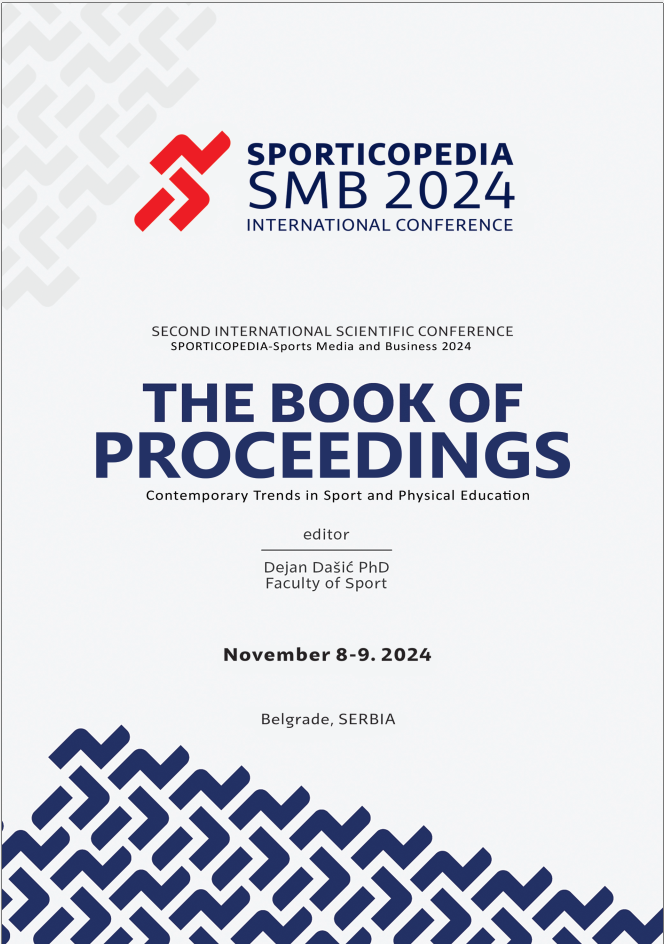Abstract
The study aimed to determine the differences in forehand stroke power between closed and semi-open stances in tennis. The strokes of 8 retired performance tennis players were analyzed, comprising 4 women (20.25±3.40 years, 166.50±4.49 cm, 66±14.57 kg) and 4 men (21.50±2.89 years, 178.38±8.44 cm, 79.45±17.97 kg). In addition to ball speed, the explosive power of the lower limbs (Squat Jump, Countermovement Jump, Countermovement Jump with Free Arms), upper limbs (medicine ball throw) and wrist flexor strength were measured. The data analysis revealed an insignificant difference between the two hitting stances, with the ball achieving similar speeds (t=0.6624, df=7, p=0.529). The ball displacement from the closed stance showed insignificant correlations with the analyzed anthropometric and strength parameters. In contrast, the semi-open stance showed significant correlations with the results of the three forms of the medicine ball throw (overhead throw – r=0.85; forehand – r=0.78; backhand – r=0.78). Striking the ball from both semi-open and closed stances results in similar ball speeds. The speed achieved from a semi-open stance is associated with the explosive strength of the upper and lower body.
References
Bahamonde, R., & Knudson, D. (2003). Kinetics of the upper extremity in the open and square stance tennis forehand. Journal of Science and Medicine in Sport, 6(1), 88-101. doi:https://doi.org/10.1016/S1440-2440(03)80012-9
Behamonde, R. (2016). BIOMECHANICS OF THE TENNIS FOREHAND STROKE. BioMechanics.
Delgado-Garcia, G, Vanrenterghem, J, Munoz-Garcia, A, . . . VM. (2019). Does stroke performance in amateur tennis players depend on functional power generating capacity? Journal of Sports Medicine and Physical Fitness, 59(5), 760-766. doi:https://doi.org/10.23736/S0022-4707.18.08518-3
Elliott, B, Reid, M, Whiteside, & D. (2019). Biomechanics of Groundstrokes. Tennis Medicine: A Complete Guide to Evaluation, Treatment, and Rehabilitation, 17. doi:https://doi.org/10.1007/978-3-319-71498-1_2
Lambrich, J., & Muehlbauer, T. (2024). The role of increased post-impact ball speed on plantar pressure during open and square stance groundstrokes in female tennis players. BMC Sports Science, Medicine and Rehabilitation, 16(1), 129. doi:https://doi.org/10.1186/s13102-024-00919-0
Landlinger, J, Lindinger, S, Stöggl, T, . . . E. (2010). Key factors and timing patterns in the tennis forehand of different skill levels. Journal of Sports Science & Medicine, 9(4), 643. doi:https://doi.org/10.1080/14763141.2010.535841
Martin, C, Sorel, A, Touzard, P, . . . R. (2020). Can the open stance forehand increase the risk of hip injuries in tennis players? Orthopaedic Journal of Sports Medicine, 8(12), 2325967120966297.doi:https://doi.org/10.1177/2325967120966297
Martin, C, Sorel, A, Touzard, P, . . . R. (2021). Influence of the forehand stance on knee biomechanics: Implications for potential injury risks in tennis players. Journal of Sports Sciences, 39(9), 992-1000. doi:https://doi.org/10.1080/02640414. 2020.1853335
Muhamad, TA, Golestani, F, Razak, A., & MR. (2016). Comparison of Open and Closed Stance Forehand Strokes among Intermediate Tennis Players. International Journal of Kinesiology and Sports Science, 4(1), 26-32. doi:https://doi.org/10.7575/aiac.ijkss.v.4n.1p.26
Nesbit, SM, Serrano, M, Elzinga, & M. (2008). The role of knee positioning and range-of-motion on the closed-stance forehand tennis swing. Journal of Sports Science & Medicine, 7(1), 114.
Parpa, K, Michaelides, M, Petrov, D, . . . AC. (2022). Relationship between Physical Performance, Anthropometric Measurements and Stroke Velocity in Youth Tennis Players. Sports, 11(1), 7. doi:https://doi.org/10.3390/sports11010007
Reid, M, Elliott, B, Crespo, & M. (2013). Mechanics and learning practices associated with the tennis forehand: a review. Journal of Sports Science & Medicine, 12(1), 225.
Rica, RL, Miranda, d. Q., JM, Gomes, JH, . . . DS. (2019). Morphological characterization of adolescents tennis players. Manual Therapy, Posturology & Rehabilitation Journal, 16.
Rigozzi, CJ, Vio, GA, Poronnik, & P. (2023). Comparison of grip strength, forearm muscle activity, and shock transmission between the forehand stroke technique of experienced and recreational tennis players using a novel wearable device. Sensors, 23(11), 5146. doi:https://doi.org/10.3390/s23115146
Schonborn, R. (2011). Tenisul, metodologia instruirii (Tennis, training methodology). Casa.
Ulbricht, A, Fernandez-Fernandez, J, Mendez-Villanueva, A, . . . A. (2016). Impact of fitness characteristics on tennis performance in elite junior tennis players. The Journal of Strength & Conditioning Research, 30(4), 989-998. doi:https://doi.org/10.1519/JSC.0000000000001267


